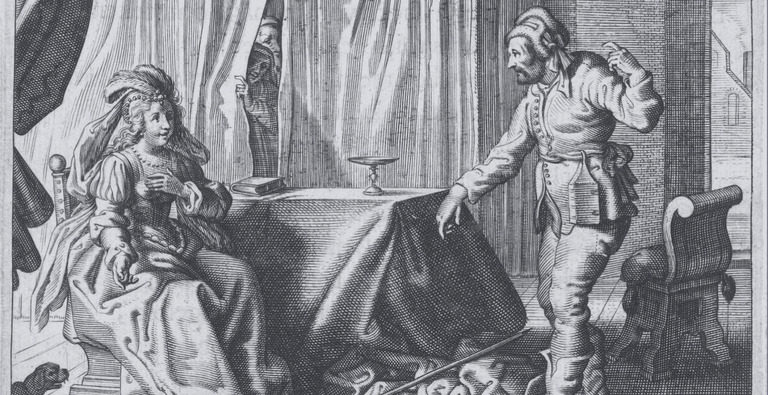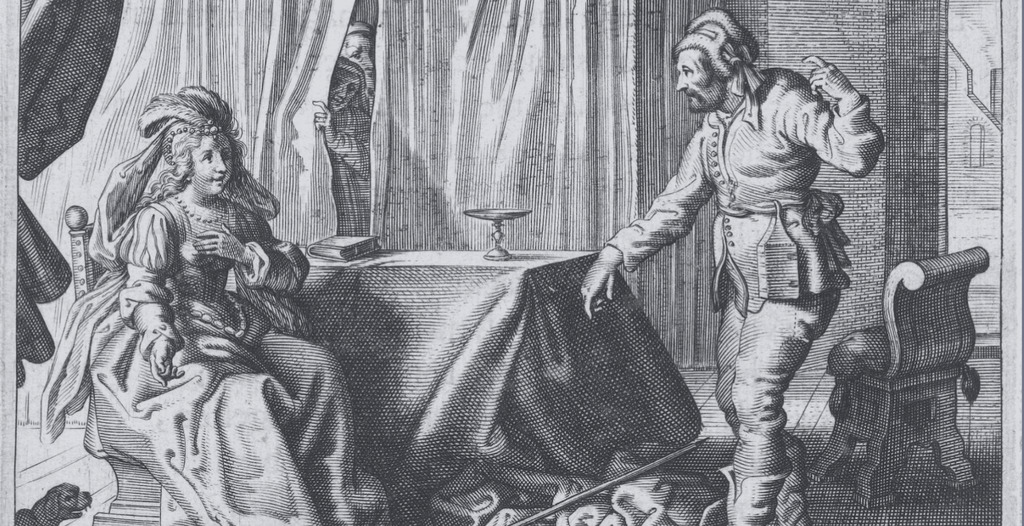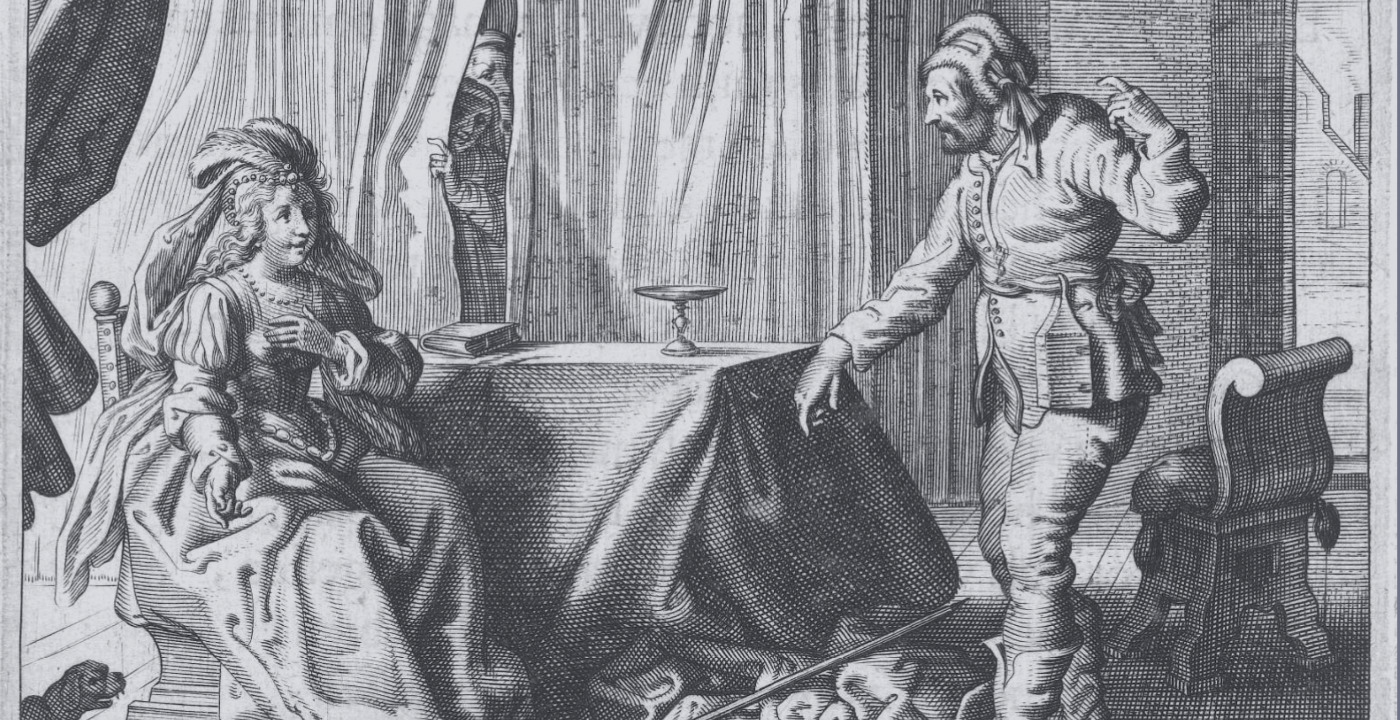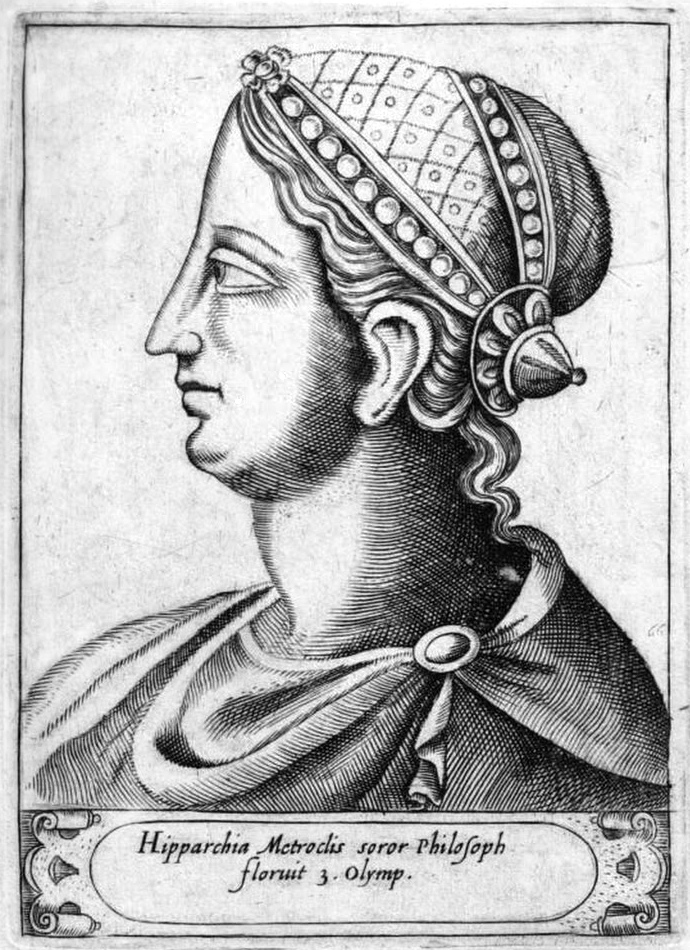Birth
ca. 350 BCE
Death
ca. 280 BCE
Hipparchia of Maroneia was a philosopher of the Cynic school of philosophy. No primary sources from her have remained and our information stems from other ancient authors such as bibliographers, doxographers, and other philosophers. These sources show that she was renowned as a philosopher in her own time, and her philosophy was later discussed by several thinkers from later antiquity to early modernity.
Cynicism was a school of philosophy that flourished during the Hellenistic era. Like virtually all Hellenistic philosophy schools, Cynicism endeavored to provide its practitioners with a philosophical guide to life that would lead to happiness (eudaimonia). For the Cynics, a good life consisted of following nature (fysis) and denouncing all unnecessary cultural customs, beliefs, and values, material possessions and social roles included.
As Cynic philosophy was first and foremost a lived and embodied praxis, our information on Hipparchia’s life provides important information on her philosophical beliefs and commitments. She challenged the gendered expectations of her time by choosing a philosophical way of life over the traditional female role with its accompanying domestic tasks. Hipparchia is particularly famous for reportedly making love in public with her husband, the fellow philosopher Crates of Thebes.
Personal Information
Name(s)
Hipparchia of Maroneia
Date and Place of Birth
ca. 350 BCE Maroneia
Date and Place of Death
ca. 280 BCE, possibly Athens
Family
Hipparchia was apparently born to a well-off family. Apuleius mentions her “noble birth” (Flor. 14.2.). Her brother Metrocles was also a Cynic.
Father: unknown
Mother: unknown
Marriage:
Hipparchia married the Cynic philosopher Crates of Thebes (c.360–280 BCE). Their wedding was celebrated in Pcecile. Ancient sources coined the term kynogamia (“dog-marriage”) to describe their exceptional partnership. In accordance with the Cynic ideals of poverty and following nature, the Cynic couple abandoned all property and lived in the streets. Several sources report that they also made love in the public. They had a son named Pasicles.
Education (short version)
According to the Suda, she was a student of Bryson from Achaia (4th century BCE), and some sources suggest that she also learnt philosophy directly from Diogenes of Sinope (c.404–c.323 BCE), one of the founders of the Cynic philosophy school. The Cynics despised traditional education, and thus Hipparchia’s Cynic education is best understood as constant practice of Cynic philosophy.
Education (longer version)
Diogenes Laertius recounts a story where a philosopher named Theodorus asks Hipparchia whether she was the one who “left her shuttle by the loom.” Hipparchia answered: “Do you think I deliberated badly on myself if, instead of wasting time upon the loom, I dedicated it to education (paideia)?” (DL 6.98). With this famous line, Hipparchia expressly identifies her Cynic way of life as education and cultivation. However, even if the Cynics are considered one of the Hellenistic philosophy schools, the Cynic school did not have any institutional or structured form. The Cynics juxtaposed nature (fysis) with tradition or culture (nomos) and declared to free themselves from the latter in order to follow the former. The Cynics abandoned traditional education together with other norms of their contemporary culture. The Cynic paideia thus ultimately signifies daily attempts to live a simple, natural life, free from the burdens caused by property and misguided beliefs and norms of the surrounding society.
The spurious collection of Cynic epistles contains several letters dedicated to Hipparchia (Malherbe 1977). In one letter, pseudo-Crates addresses her: “For you are not by nature inferior to us, for female dogs are not by nature inferior to male dogs” (Crates’ letter 29: 10–17 in Malherbe 1977). This is an allusion to Plato’s Republic where Socrates defends the idea that the men and women of the ideal republic should receive the same education. Ancient philosophers debated whether men and women had the same predispositions towards virtue; the early Cynic Antisthenes had defended the position that they did (DL 6.12.). Thus, even if the Cynic education is radically different from the educational programme of Plato’s utopian state, both agreed that women and men could receive the same education and become virtuous.
The sources present Hipparchia as a literate woman. The tenth-century Byzantine lexicon Suda reports that she wrote philosophical texts. The anonymous authors of the Cynic letters emphasize her participation in philosophical correspondence which was an important philosophical genre in the Hellenistic era. Pseudo-Diogenes’ letter to Hipparchia urges her to write to him frequently, indicating that the letter’s anonymous author wished to present Diogenes as Hipparchia’s mentor and interlocutor (Diogenes’ letter 3., in Malherbe 1977).
Religion
Not much information is provided on Hipparchia’s religious beliefs, but as the Cynic philosophers abandoned nomos (cultural customs and beliefs), they would have also rejected traditional religious practices.
Transformation(s)
Hipparchia defied the customs of her society by choosing Crates as her spouse. According to Diogenes Laertius, she fell in love with his life (bios) and teachings (logos) which indicates that she chose her partner precisely for his philosophical way of life. This was a radical choice in her social context where girls were usually married off as teenagers, without having the freedom to choose either their spouses or ways of living. Hipparchia dedicated herself to the Cynic ascetic lifestyle, dressing in a coarse cloak, living in the streets, and attending symposia with her husband. Probably the life-event that has received the most comment throughout history is her public lovemaking with Crates. Later authors such as Augustine of Hippo discussed this as sexual promiscuity, but in the context of Cynic philosophy, this act can be seen an expression of their central values of following nature, critiquing social expectations, and exercising the Cynic virtue of shamelessness or unabashedness (anaischyntia) (cf., Dutsch 2018).
By practicing philosophy in the agora, Hipparchia rejected the gender norms of her contemporary society which reserved the public space to men and assigned indoor labor such as wool spinning to women. When Hipparchia announced to Theodorus that she deliberately chose a life of education over spinning, she juxtaposed philosophical education with the traditional female role of her time (cf., Grahn-Wilder 2024).
Contemporaneous Network(s)
Hipparchia practiced philosophy with her husband Crates. Her brother Metrocles was also a Cynic, and a student of Crates. Ancient sources suggest that she also was connected to other philosophers of her time such as Diogenes of Sinope, Bryson from Achaia, and Theodorus.
less
Significance
Works / Agency
No original works by Hipparchia have remained. The Suda mentions that she authored philosophical texts, and the (spurious) collection of Cynic epistles includes several letters dedicated to her (collected in Malherbe 1977). Hipparchia is mostly renowned for her agency, particularly her decision to abandon the traditional female role to dedicate her life to philosophy, and for breaking against her contemporaneous norms for marriage and sexual conduct by living with her chosen husband in the streets and making love in public. Since Cynicism was first and foremost a lived and embodied praxis, the biographical information on Hipparchia is the most important evidence on her philosophical activity.
Reputation
Hipparchia is the only woman to whom Diogenes Laertius dedicates a whole chapter in his Lives of Eminent Philosophers, and her later reputation relies largely on this source. Hipparchia received her own entry in the tenth-century Byzantine Encyclopedia Suda, and she is discussed by many ancient and early Christian writers, such as Epictetus, Sextus Empiricus, Clement of Alexandria, Apuleius, Tatian, and Augustine. Augustine discusses her controversial marriage in his The City of God against the Pagans (book IV). Several early modern authors discuss her as a philosopher. For example, Gilles Ménage (1613-1692) devotes a chapter to Hipparchia in his work The History of Women Philosophers (Historia mulierum philosopharum, 1690–1692). Pierre Bayle (1647–1706) discusses her in his Historical and Critical Dictionary (1697), and Mary Hays (1759– 1843) in her Female Biography (first published 1803). Peter Petit wrote a poem on Hipparchia’s and Crates’ marriage named Cynogamia sive de Cratetis et Hipparches amoribus in 1676, and in late 17th century Clemenza Ninci, an author and a nun, wrote the play Sposalizia d’Iparchia Filosofa (“The Marriage of Female Philosopher Hipparchia”). The play was apparently acted solely by nuns.
After the early modern era, however, Hipparchia’s name is mostly absent from historical accounts of ancient philosophy. Johann Jakob Brucker and William Enfield’s The History of Philosophy: from the earliest times to the beginning of the present century, drawn up from Brucker’s Historia critica philosophiae (1791) is one of the few exceptions. Hipparchia has been a highly marginalized thinker also in more contemporary academic research, but there is a growing interest in the achievements and influence of ancient female philosophers which has resulted in new publications such as The Routledge Handbook of Women and Ancient Greek Philosophy, edited by Sara Brill and Catherine McKeen (2024).
Legacy and Influence
Ancient authors coined the terms kynogamia (“dog-marriage”) and synkynizein (“to practice Cynicism together”) to describe Hipparchia and Crates’ marital life and philosophical activity. One of Pseudo-Diogenes’ letters praises the inhabitants Maroniea for renaming the city after Hipparchia (Diogenes’ letter 43., in Malherbe 1977). Michelle Le Dœuff discusses Hipparchia in her classic feminist work L’Etude et le Rouet, originally published in 1989 (translated to English as Hipparchia’s Choice – An Essay Concerning Women, Philosophy, etc.). Hipparchia’s name appears on the heritage floor section of Judy Chicago’s legendary feminist spatial artwork Dinner Party from 1979 (on display at Brooklyn Museum). Comic artist Barbara Stok provides a visual interpretation of Hipparchia’s story in her graphic novel The Philosopher, the Dog, and the Wedding (published by SelfMadeHero in 2022).
less
Controversies
Controversies
The most famous controversy concerns Hipparchia and Crates’ public lovemaking. The ancient sources coined the terms kynogamia to denote their exceptional marriage, and their public lovemaking evoked comment by Hellenistic and Roman philosophers such as Epictetus and Sextus Empiricus, as well as authors such as Tatian, Apuleius, and Augustine. The conversation continued in early modern philosophy.
In her own time, Hipparchia made highly exceptional choices by deciding to practice philosophy, abandoning the traditional female role, and appearing in public spaces and events such as symposia traditionally reserved to men. Throughout Western history, the Cynics have been considered a controversial school of philosophy because of their provocative rhetorical style, explicit disregard of the prevailing standards of behavior, and admiration of the simplicity of animal life. Therefore, Hipparchia remains a controversial figure within the Western history of philosophy not only on account of her gender but also because she was a Cynic; the Cynics have been regularly marginalized in the standard accounts of ancient philosophy.
New and Unfolding Interpretations
New interpretations have highlighted the radicalness of Hipparchia’s critique of binary gender norms by paying attention to different aspects of her agency. Grahn-Wilder has analysed Hipparchia’s biography against the backdrop of ancient economic theory, highlighting the significance of transcending gendered division of labor and the juxtaposition between public and private space (2018 & 2024). Kennedy has discussed Hipparchia’s audacious usage of freedom of speech and feminist rhetoric (1999). Dutsch has emphasized Hipparchia’s sexual and bodily agency, and way of creating Cynic sexual ethics (2018). Comparing Cynicism to the punk rock movement, Gregory Blaire suggests that Hipparchia used her “errant body” to question the gendered expectations of her time (2018).
less
Bibliography
Primary (selected):
Adler, A.: Suidae Lexicon, Pars 1., in Lexicographi Graeci vol 1.–3., Lipsiae, Teubner, 1928.
Apuleius: Apologia. Florida. De Deo Socratis. Christopher P. Jones (ed. and transl.). Harvard University Press, 2017.
Clement of Alexandria: Stromata or Miscellanies. Aeterna Press, 2016.
Diogenes Laertius: Lives of Eminent Philosophers, trans. R.D. Hicks, Cambridge and London: Harvard University Press, 1995.
Diogenes the Cynic: Sayings and Anecdotes: With Other Popular Moralists, Robin Hard (trans.). Oxford: Oxford University Press, 2012.
Dobbin, R. (ed. and trans.): The Cynic Philosophers from Diogenes to Julian, Penguin Classics, 2012.
Malherbe, A.J.: The Cynic Epistles:A Study Edition, Sources for Biblical Literature. Missoula, MT: Scholars Press, 1977.
Web Resources (selected):
The Suda online: https://www.cs.uky.edu/~raphael/sol/sol-html/
Diogenes Laertius’ Lives of Eminent Philosophers online: http://www.perseus.tufts.edu/hopper/collections
Grahn-Wilder, Malin (2023), Entries on Hipparchia in Encyclopedia of Concise Concepts by Women Philosophers, edited by Ruth Hagengruber and Mary Allen Waithe:
- Economics in Hipparchia of Maroneia (ca. 350–280 BCE)
- Education in Hipparchia of Maroneia (ca. 350–280 BCE)
- Marriage in Hipparchia of Maroneia (ca. 350–280 BCE)
- Sexuality in Hipparchia of Maroneia (ca. 350–280 BCE)
Grahn-Wilder, Malin (2018): Gender and Sexuality in Stoic Philosophy. New York: Palgrave Macmillan.
Issues with the Sources
We do not have any original sources by Hipparchia herself, and therefore our information relies on later ancient authors (bibliographers, doxographers, and philosophers).
Selected scholarship:
Gregory Blaire: “Cynics and Punks”, in Errant Bodies, Mobility, and Political Resistance, New York: Palgrave Macmillan, 2018.
Dutsch, Dorota: ”Dog-love-dog: Kynogamia and Cynic sexual ethics”, in M. Masterson, N. Rabinowitz and J. Robson (ed.) Sex in Antiquity – Exploring Gender and Sexuality in the Ancient World, London and New York: Routledge, 2018: 245–259.
Grahn-Wilder, Malin: “Wives or Philosophers? Hipparchia and the Cynic Criticism of Gendered Economics”. In The Routledge Handbook of Women and Ancient Greek Philosophy, S. Brill & C. McKeen (eds.), Routledge, 2024.
Kennedy, Kristen: “Hipparchia the Cynic: Feminist Rhetoric and the Ethics of Embodiment”, Hypatia, Volume 14, Number 2, Spring 1999: 48-71.
- Images
Fresco of Hipparchia and Crates (ca. 1st century) from the garden of Villa Farnesia, Museo delle Terme, Rome, public domain. URL: https://commons.wikimedia.org/wiki/File:Crates_and_Hipparchia_Villa_Farnesina.jpg
Engraving of Hipparchia from Girolamo Olgiati’s book Illustrium philosophorum et sapientum effigies ab eorum numistatibus extractae (1580), public domain. URL: https://commons.wikimedia.org/wiki/File:Hipparchia_-_Illustrium_philosophorum_et_sapientum_effigies_ab_eorum_numistatibus_extractae.png
Illustration of Hipparchia and Crates wearing 17th century attire from the book Proefsteen van de Trou-ringh (“Touchstone of the Wedding Ring”) by Jacob Cats (1637), public domain. URL:
https://commons.wikimedia.org/wiki/File:Hipparchia_and_crates_cats.jpg






Comment
Your message was sent successfully